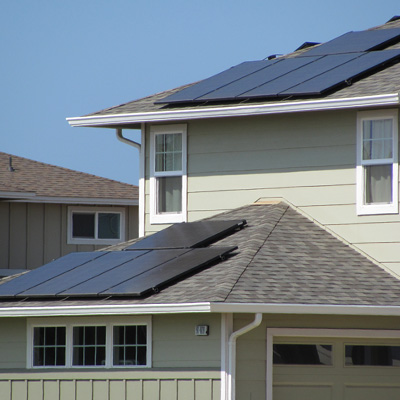And how do they know what my gross consumption is? If I do not send back, or pull from them, they have no idea what I am using or generating it seems?
Without a NGOM, they can only estimate it. So it's likely going to be based on your array size.
You can install our site as a web app on your iOS device by utilizing the Add to Home Screen feature in Safari. Please see this thread for more details on this.
Note: This feature may not be available in some browsers.
And how do they know what my gross consumption is? If I do not send back, or pull from them, they have no idea what I am using or generating it seems?
I went to go look for any prior usage of "Gross consumption of electricity" by the CPUC and there aren't any hits. Looking for a definition of this phrase it appears to be "Gross consumption of electricity is the sum of gross production of electricity and imports less exports of power." This would lean towards the Solar Rights org's interpertation.And how do they know what my gross consumption is? If I do not send back, or pull from them, they have no idea what I am using or generating it seems?
I went to go look for any prior usage of "Gross consumption of electricity" by the CPUC and there aren't any hits. Looking for a definition of this phrase it appears to be "Gross consumption of electricity is the sum of gross production of electricity and imports less exports of power." This would lean towards the Solar Rights org's interpertation.
How can they figure this out? The CPUC can't do this precisely as there isn't any requirement for a meter after the solar invertor. So, they might opt for the using the AC rated component of the system (NEM 3.0 proposal) to estimate, but they really should be using the monthly PV estimate formula that is specific to your system and location based on the PTO documents.
I think that you misunderstood what the definition appears to be "Gross consumption of electricity is the sum of gross production of electricity and imports less exports of power."That formula is . . . inadequate in many cases, particularly those houses that have installed batteries. I have a 16kw solar system, by that definition, I should be taxed like mad. But when you factor in that the bulk is self consumption and that I'm a next exporter for the year, the formula breaks down on a "fairness" scale.
Mass battery adoption is accelerating, the utilities know this, and they are trying very VERY hard to get something like this in place so that they can continue to milk their customers for egregious profits for little actual grid usage. It's a "directed tax" that goes straight to the utilities' bottom line.
The Texas system is broken. When prices reach $9000/MWh, they should have told people about it in real time! There's no purpose of having market pricing if you're not going to tell people what price they're paying. It's like having a refinery interruption and raising the price of gas to $100/gallon, but just not telling anyone about it. Then gas stations start running out of gas because people are still buying gas like it's $4/gallon, but you've got a refinery down, so they run out of gas, and then at the end of the month, people get hit with $2000 gasoline bills. But wait! Wasn't the purpose of raising the price to $100/gallon to get demand down and avoid a shortage? Except they didn't tell anyone about it, they just gouged people, and ended up with a shortage anyway.
Real time market pricing requires communicating the pricing to customers in real time.
They aren't giving up. Snuck a solar tax into Diablo nuclear bill
Update: Solar Tax defeated, again!
We are happy to report that the authors of SB 846 have agreed to clarify in writing that the bill will not impose a Solar Tax on the solar energy you produce and consume at home. In other words, you helped defeat the Solar Tax. Again. This is the third time in the last year we have had to fight...solarrights.org



California set to release anti-rooftop solar net metering plan
Previous drafts of the plan slashed the value of rooftop solar blaming rich solar-owning Californians for a utility cost shift to less wealthy residents. A new study by Berkeley Labs showed that middle-income and working-class Californians were by far the largest buyers of rooftop residential solar.pv-magazine-usa.com

Sounds good - anyone able to find the actual proposed rates there? I haven't been able to find them...A sensible rate structure.

Hawaii moves to time-varying 'smart' rates for most utility customers
The first-in-the-nation statewide plan will nudge residents to shift their energy use to times that best align with Hawaii's increasingly solar-powered grid.www.canarymedia.com
California should use this order as the model for their decision on the future of net metering,” Lazar said. “You don’t have to discriminate against solar customers; you can apply this rate to everybody.”
California’s proposed “dumb rates” slap fees on customers regardless of whether they behave in ways that help or hurt the broader electricity system. A household could buy a battery, store solar production through the afternoon and discharge it when the grid desperately needs clean peak power in the evening, but that household would still have to pay the same generic solar fee as a mansion that dumps unwanted solar on the grid at noon and uses immense amounts of power in the evenings.
Sounds good - anyone able to find the actual proposed rates there? I haven't been able to find them...

So, I think that's only part of it as that doesn't give you the TOU rates, or the demand charge that was mentioned in the article.
Effective Rate Summary
The monthly effective rate summaries for Hawaiian Electric shows the rate schedules and adjustments approved by the PUC.www.hawaiianelectric.com


Actually that analogy is more apt and more penetrating than most people might think. Both in relationship to energy and in relationship to the medical industrial complex obfuscation of core realities is a central strategy by the plutocrats to maintain control over a system that is staggeringly profitable for them. In the utilities sphere there are a host of lies promulgated by these so-called publicly owned corporations. The real point of anti-net metering rules is to destroy the existential threat of rooftop solar and batteries to their obscene profit levels. A decentralized grid means no more guaranteed monopoly with guaranteed profits. It's great to see the anti-net metering folks talk about how they are "free market Republicans" and supporting the poor against the rich elitist solar radicals.Reminds me of our healthcare system...


